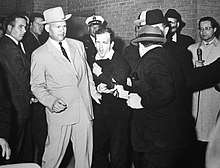Robert H. Jackson (photographer)
Robert "Bob" Hill Jackson (born April 8, 1934) is an American photographer. In 1964, Jackson, then working for the Dallas Times Herald, was awarded the Pulitzer Prize for Photography for his photograph of the murder of Lee Harvey Oswald by Jack Ruby.[1][2][3]

Early life and career
Born on April 8, 1934, Jackson grew up in Dallas. His interest in photography began when he was 12 or 13. An aunt gave him a Baby Brownie Special camera, and a family cat became one of his first subjects. When Jackson turned 14, his interest became more serious. Another aunt gave him an Argus C-3 35 mm camera. Jackson’s first news photo was of a double fatality crash in northern Dallas. Jackson persuaded his father to drive him to the scene of the crash. His second news photo was of an airplane crash at Love Field.[4] Jackson attended Highland Park High School, and later Southern Methodist University, leaving the University in 1957.[5]
His photography interest grew when he began photographing sports car racing. He joined the 36th Infantry National Guard. While in the Army, Jackson became a photographer for an Army general.[4] In August 1960, the Dallas Times Herald hired him.[5]
November 1963
On November 22, 1963, Jackson was assigned to cover President John F. Kennedy's arrival at Love Field and his motorcade through the city. Jackson and many other journalists traveled with the President and first lady from the airport. He was in the eighth vehicle behind the presidential limousine as the motorcade headed down Elm Street. Jackson was sitting atop the back seat of the convertible as the motorcade approached Dealey Plaza. He was in the process of changing film when the shots were fired; but his camera was empty. He had just removed a roll of film to hand-off to another newspaper employee, and had not yet reloaded. However, he was among the few people who thought that they saw a rifle barrel in the window of the book depository. After the assassination, Jackson remained in Dealey Plaza, but took no more photos, something he later regretted.[1]
Two days later, Jackson was told to go to the police station to photograph the transfer of Oswald to the county jail. Using his Nikon S3 35mm camera, Jackson photographed the murder of Oswald by Jack Ruby in the Dallas police station garage.[1] In March 1964, Jackson was called to testify in front of the Warren Commission, but he never took the stand.[6]
Later life
In later life, Jackson was a staff photographer for the Colorado Springs Gazette-Telegraph. He retired from the Gazette in 1999. He has three daughters, two sons from his wife's previous marriage and a son with his current wife. He also has 10 grandchildren.[4] As of November 2013, Jackson resides in Manitou Springs, Colorado.[4][1]
References
- Meyer, Jeremy P. (23 November 2013). "Bob Jackson's iconic photo of Ruby shooting Oswald still resonates". The Denver Post.
- Granberry, Michael (5 April 2010). "Six-Tenths of a Second, Two Lives Forever Changed".
- Fischer, Heinz-D; Fischer, Erika J. (2003). Complete Historical Handbook of the Pulitzer Prize System 1917-2000: Decision-Making Processes in all Award Categories based on unpublished Sources. Walter de Gruyter. ISBN 9783110939125.
- Boyle, Jim (10 November 2013). "JFK series: Newspaper photographer witnesses historic shootings".
- "Testimony of Robert H. Jackson".
- "A Photographer's Story: Bob Jackson and the Kennedy Assassination". The Sixth Floor Museum at Dealey Plaza. Archived from the original on July 6, 2010.
External links
- Six-tenths of a second, 2 lives forever changed at the Dallas Morning News, January 27, 2004